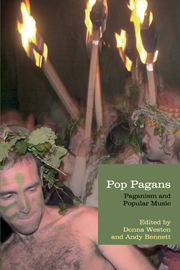Book contents
- Frontmatter
- Contents
- Contributors
- Foreword
- 1 Towards a definition of Pagan music
- Part I Histories
- Part II Genres
- Part III Performance
- 8 Dancing Paganism: music, dance and Pagan identity
- 9 Total solar eclipse festivals, cosmic pilgrims and planetary culture
- 10 Techno-shamanism and the economy of ecstasy as a religious experience
- Part IV Communities
- Bibliography
- Discography and filmography
- Index
9 - Total solar eclipse festivals, cosmic pilgrims and planetary culture
from Part III - Performance
- Frontmatter
- Contents
- Contributors
- Foreword
- 1 Towards a definition of Pagan music
- Part I Histories
- Part II Genres
- Part III Performance
- 8 Dancing Paganism: music, dance and Pagan identity
- 9 Total solar eclipse festivals, cosmic pilgrims and planetary culture
- 10 Techno-shamanism and the economy of ecstasy as a religious experience
- Part IV Communities
- Bibliography
- Discography and filmography
- Index
Summary
“Once I saw people applaud the sky” (Weil 1980). It was 7 March 1970, and later maven of integrative medicine Andrew Weil had become an eyewitness to an extraordinary life-changing event. Under a clear Saturday morning sky, Weil had observed a diversity of villagers crowding into the market town of Miahuatlán, Oaxaca, Mexico, where they were exposed to a total solar eclipse. Marvelling at the sky, the locals are reported to have broken into a “spontaneous ovation of the heavens”: Weil describes the excitement: “With great drama, a nebulous darkness grew out of the west – the edge of the umbra, or cone of shadow, whose swift passage over the globe traces the path of the total eclipse.” The unearthly light endured for over three minutes, a temporality expanding into a prolonged present. Weil explained that there was
a quality to those minutes within the umbra that must be like the feeling in the eye of a hurricane. After all the dramatic changes of accelerating intensity, everything stopped: There was an improbable sense of peace and equilibrium. Time did not flow.
(Ibid.: 222)
Indeed, it was three and a half minutes of clock-time incomparable to any duration he'd previously known. “Then, all at once, a spot of blinding yellow light appeared, the corona vanished in the glare, shadow bands raced across the landscape once more, and the dome of shadow melted away to the east” (ibid.: 223). It was then that all of Miahuatlán broke into applause.
- Type
- Chapter
- Information
- Pop PagansPaganism and Popular Music, pp. 126 - 144Publisher: Acumen PublishingPrint publication year: 2013



